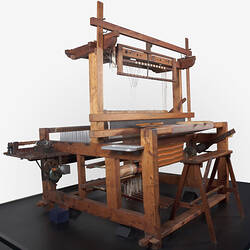Summary
Metal reed from the countermarch floor loom. The reed clamps to the loom beater and ensures warp threads are correctly spaced. It also packs the weft threads into place and it's width is an indication of the weaving width. The Countermarch Floor Loom was made for Anna Apinis by fellow survivors of World War II, in Memmingen, a displaced persons camp in Germany with wood scavenged from bombed-out ruins. It was designed by Anna's husband Ervins. Anna used the loom to weave traditional Latvian designs using threads gathered by unraveling old scraps of fabric. Anna brought the loom with her to Australia and continued to weave Latvian designs on it.
Physical Description
Long, thin metal frame. Wide and rectangular in shape, it contains many thin vertical metal strips or teeth. The top and bottom rails of the reed are covered with a worn and discoloured black tape-like material, much of which has browned, cracked or peeled off. A chipped and worn yellow section is visible in the centre of the top rail with partially handwritten numbers and evidence of text. Off-white coloured masking tape has been applied at each corner of the reed. The reed is wrapped in a long, thin fabric pocket with a blue, red and green floral design. Several pins hold it in place.
More Information
-
Collecting Areas
-
Acquisition Information
Donation from Mrs Anita Apinis-Herman, 01 Nov 2006
-
Place & Date Made
-
Designer
Mr Ervins Apinis, Memmingen, Germany, circa 1945
Of the Countermarch Floor Loom -
User
-
User
-
Inscriptions
Handwritten on top rail: '1 cm / 102061 / 25...'
-
Classification
-
Category
-
Discipline
-
Type of item
-
Overall Dimensions
104.5 cm (Length), 13 cm (Width), 1.2 cm (Height)
-
Keywords
Handcrafts, Latvian Communities, Latvian Immigration, Looms, Weaving, Woodworking

